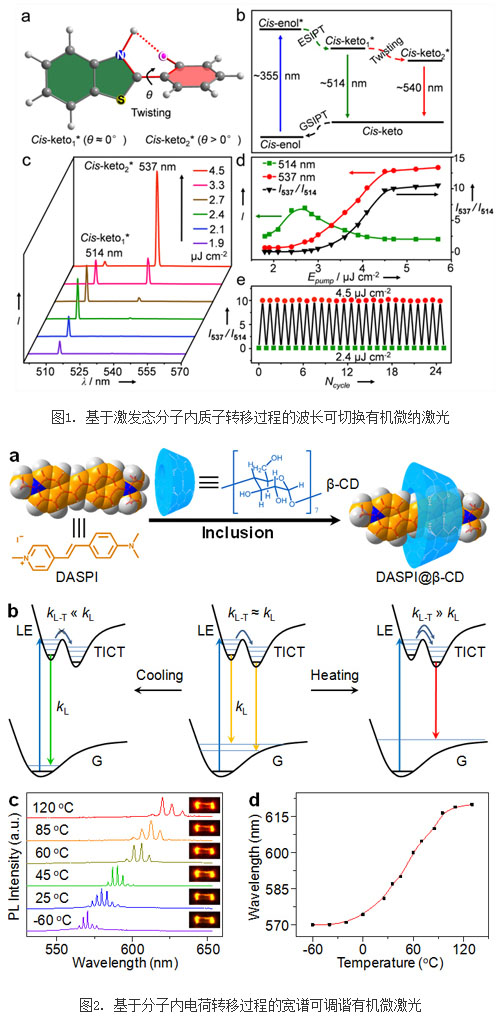
Laser is one of the greatest inventions of mankind since the 20th century. It has been widely used in military defense, industrial production, and people's daily life. These fields involve a series of strategic emerging industries such as energy, information, and biomedicine. With the advancement of science and technology, laser technology has also continued to develop, and micro-nano lasers are the frontier of research that intersects laser technology and nanoscience. At the micro/nano scale, the three laser elements (resonant cavity, gain medium, pump source) are significantly different from those of conventional lasers. Under the strong support of the National Natural Science Foundation of China, the Ministry of Science and Technology, and the Chinese Academy of Sciences, Zhao Yongsheng, a member of the Key Laboratory of Photochemistry of the Institute of Chemistry, Chinese Academy of Sciences, has devoted his research to organic micro-nano laser materials and devices. Controllable Assembly of Micro-Nano Resonator Structures (J. Am. Chem. Soc. 2011, 133, 7276-7279; Chem. Soc. Rev. 2014, 43, 4325-4340), Whispering-wall mode organic micro-nano lasers (J Am. Chem. Soc. 2014, 137, 62-65,; Acc. Chem. Res. 2014, 47, 3448-3458), and large-area controlled integration of organic micro-nano lasers (Science Advances 2015, 1, e1500257 ) etc. carried out systematic research work.
Studies have found that organic materials show unique advantages in terms of luminous efficiency, flexibility, and processability. The organic molecules are rich in species, the structure can be designed, the properties can be tailored, and there is great flexibility in the choice of materials. At the same time, the organic materials generally have large cross-sections of light absorption and light radiation, and the use of the characteristics of easy doping of organic materials can achieve full The continuously adjustable stimulated emission of the band solves the problem of shortage of laser materials in the current ultraviolet and infrared bands. More crucially, the organic laser generation process involves a new population inversion and stimulated emission mechanism.
In a recent study, the researchers selected a typical four-level molecular system with an excited-state intramolecular proton transfer (ESIPT) process. Through liquid-phase assembly, a high-quality one-dimensional single-crystal structure Fabry- Perot mode resonator. In such single crystal nanomaterials, the ground state molecules exist in enol form (E) and become more stable through intermolecular hydrogen bonding. When the molecule is excited, due to the redistribution of charge within the molecule, the acidity of the proton donor increases, the alkalinity of the proton acceptor increases, and the intramolecular proton transfer is caused in the picosecond time period. The result is that the excited state molecule is mainly Present in keto form (K). The excited K structure can decay back to the ground state E structure through effective fluorescence radiation. Thus, the ESIPT process can form a complete four-level system. Among them, the E structure and the K structure have distinct molecular configurations and electronic structures, resulting in a large Stokes shift between light absorption and emission, thereby effectively suppressing the self-absorption loss in the gain process and facilitating the construction of a low level. The threshold micro-nano laser. On this basis, through the external action, the energy level of the excited state of the keto structure is further regulated, and an organic micro-nano laser with a wavelength switchable is realized (Fig. 1). The relevant research results were published in "Angew. Chem. Int. Ed. 2015, 54, 7125-7129".
Further, researchers selected compounds with intramolecular charge transfer (ICT) properties as the gain material to construct organic micro-nano lasers. These compounds have two upper levels, and the energy level structure and the excited state process have specific responses to different environments. First, through the design of the supramolecular confinement system, the control of the population of two upper energy levels is achieved. Through steady state and transient spectral analysis, a new laser generation mechanism based on the two upper energy states cooperative gains is proposed. This mechanism provides a way to control the gain interval by controlling the distribution of the number of the two upper energy states. New ideas. Based on this, by controlling the charge transfer process in the molecule by changing the ambient temperature in real time, the gain range of the organic supramolecular crystallites is effectively regulated, and a wide-spectrum micro laser with a continuously adjustable emission interval is realized (Fig. 2). The relevant research results were published in the "Journal of the American Chemical Society" (J. Am. Chem. Soc. 2016, 138, 1118-1121).
The above results indicate that the abundant excited state process in organic materials provides a more effective and controllable way for constructing a four-level system that is in favor of population inversion, and in addition, various materials exhibited under stimulated conditions Spectral characteristics also provide a more powerful means for in-depth study of the excited state dynamics of organic molecules. The related research helps to deeply understand the organic micro-nano laser gain process and has important guiding significance for designing and developing new principles and new performance laser devices.
Kitchen gadgets,High Quality Kitchen gadgets,Kitchen gadgets Details, CN
Yangjiang YJCB Trade Co., Ltd , https://www.cbprokitchen.com
